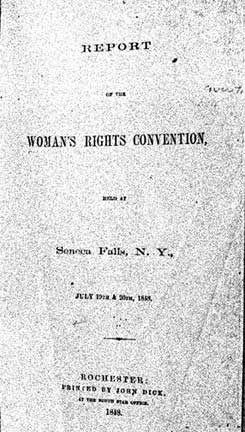
Convention
The first national Women's Conference was held in Worcester, Massachusetts. The meeting followed a local convention in Seneca Falls the year before. The convention, after much discussion, passed a resolution that stated: "Women are clearly entitled to the right of suffrage, and to equality before the law, without distinction of sex or color."
Women’s rights in American society had deteriorated from early colonial times to the 1830’s. In earlier colonial society women were considered nearly equal to men. However, as the nexus of American life moved to the cities, the role of women was relegated to the home. The husbands were the breadwinners and the wives stayed home to take care of the children and the house. Of course women did not yet have the right to vote.
Women became involved in the "abolitionist" or Anti-Slave movement in significant numbers. A large number of those women were Quakers (who were most liberal in giving women some role in church life.) In 1840, Lucretia Mott and Elizabeth Cady Stanton travelled to London, with their husbands, for the world's first Anti-Slavery Convention. Once there, Mott and Stanton were surprised that women were not allowed to sit on the floor of the convention. Rather, women were relegated to a curtained balcony. Their husbands sat with them in the balcony in protest. During their time in London, Mott and Stanton became friends. The two vowed to organize a women’s rights meeting in the United States.
It took them nearly eight years to get organized. However, on July 9th, 1848 Loretta Motts and Elizabeth Stanton agreed to hold the first Women’s Convention (together with Mary Ann McClintock, Martha Coffin Wright, and Jane Hunt.) The call to attend the convention went out in local papers. The convention met on July 19th,1848 at the Wesleyan Methodist Chapel in Seneca Falls. 300 women and 50 men attended the convention. They met together for two days. At the end of the two-day session the assembly adopted a set of Resolutions called, "The Sentiments". The sentiments represented a call for the full rights of woman, in all spheres.
Several regional Women’s Conference then followed, as a result of the success of the first convention. A call went out, at the May 1850 Annual Anti-Slavery Meeting in Boston, for anyone who wanted to stay on to work planning a National Womens' Rights Convention. On October 23rd, 1850, 900 people showed up for the first session of the first National Womens' Rights Conference, at Briney Hall in Worcester Mass.
Palina Davis was elected President of the conference. Davis gave the first keynote speech calling for the "emancipation of a class", "the redemption of half the world", and "a conforming re-organization of all social, political, and industrial interests and institutions."
A distinguished list of speakers addressed the historic convention. Lucy Stone, one of the key organizers of the meeting made the final major speech. Stone stated: “We want to be something more than the appendages of society; we want that Woman should be the co-equal and help-meet of Man, in all the interest and perils and enjoyments of human life. We want that she should attain to the development of her nature and womanhood; we want that when she dies, it may not be written on her gravestone that she was the 'relict' of somebody”
Lucy Stone went on to organize seven more national conventions.
 >
>